In the latest in our series of Know Your Ferraris, we look at the Dino family of Ferraris and their close cousins built by Fiat.
The tale of Dino is one that starts with tragedy but ultimately led to one of the most successful competition engines and, as mentioned above, a line of road cars from two different manufacturers.
Alfredino ‘Dino’ Ferrari was born on the 19th January 1932, the only son of Enzo Ferrari and his wife Laura. His life would be tragically cut short by complications from Muscular Dystrophy on the 30th June 1956. The legend as told by his father was that in his dying days he conceived a new V6 engine that would power a new generation of F1 and sports cars. This engine would carry the name Dino.
It's more than likely that the engine was actually the work of engine design legend Vittorio Jano, who had returned to work at Ferrari when they acquired the Lancia F1 programme a few years before. In various forms, the engine would go on to provide Ferrari with the World Championship in 1958 and power a 246F1 to the last win by a front-engined GP car at Monza in 1960. In 1961 the Dino-powered 156 Sharknose would herald a new generation of mid-engined F1 Ferraris. Phil Hill would take the championship in the new car. That same year also saw the debut of Ferrari’s first mid-engined sports racer, the Dino-powered 246SP.
By the mid-Sixties, regulation changes made the Dino obsolete in F1 but Ferrari realised the engine could be suitable for the new Formula 2 regulations for 1967. The F2 regulations required a production-based engine block with at least 500 units made. Ferrari did not have the capacity to produce that many engines, so approached Fiat with a view to a collaborative project that would result in both Fiat and Ferrari cars using this engine.
Ferrari engineer Franco Rocchi and Fiat engineer Aurelio Lampredi (who was also a former chief engineer at Ferrari) worked to create a production version of the alloy 2.0 litre 65-degree 4-cam V6, and the first cars to carry these engines appeared at the Turin Motor show in November 1966.
Fiat Dino Coupé and Spyder
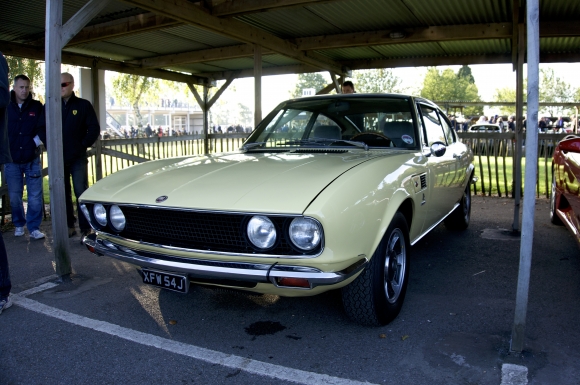
Fiat was first to utilise this engine in two cars, the Dino Coupé bodied by Bertone and the Spyder which was bodied by Pininfarina. Both cars shared the same mechanical layout with the engine rated at 160bhp, mounted in the front. The engine was fed by three Weber carburettors and mated to a 5-speed gearbox. Suspension components were taken from the Fiat 125 (yes, the car that later sired the FSO Polonez!), meaning a live rear axle suspended by leaf springs. The Coupé featured a slightly longer wheelbase to allow for 2+2 seating, although the Spyder also has a nominal rear bench. The Fiat Dino had one other world first as the first road car to feature electronic ignition in the form of the Magnetti Marelli Dinoplex system.
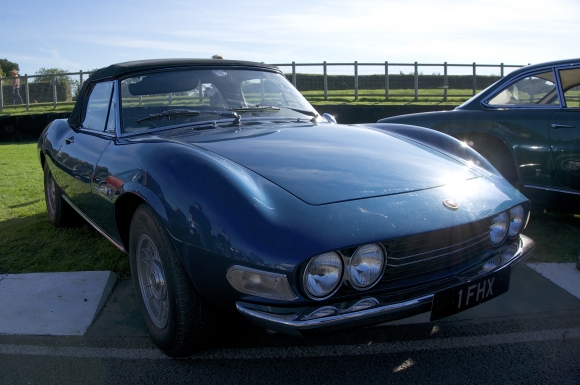
Bertone went for subtly in the Coupé with a neat, elegant style. Pininfarina was rather more flamboyant, with the Spyder featuring four headlights recessed into the grille and a rear that aped Ferraris with its four circular tail lamps.
Both cars were halo models for the rest of the Fiat range and competed with the likes of the Alfa Romeo 2600, Lancia Flaminia and Mercedes Benz SL. They don’t have a modern equivalent in the current Fiat range (or even the wider group), so perhaps the closest equivalents for the Coupé today would be the higher-end versions of the BMW 4 Series and the Audi A5.
The car received some significant updates in 1968. The engine was enlarged to 2.4 litres and the block was changed from alloy to steel. As a result, power output increased to a claimed 180bhp. The car also gained the independent rear suspension from the Fiat 130. Final assembly of the 2.4 litre cars was transferred to Ferrari's factory at Maranello, which coincided with Fiat’s 50% acquisition of Ferrari.
Production continued through to 1973 when both the Coupé and Spyder were discontinued without direct replacements; the Fiat 130 Coupé could be seen as the Dino’s replacement but they sat side by side in the range from 1971. Curiously, although it was in production for a shorter period of time, the 2.0 versions are the most numerous with 3670 2.0 Coupés and 1163 2.0 Spyders produced. Ferrari assembled 2398 2.4 Coupés and a mere 420 Spyders.
In both forms the Fiat Dino is little known in the UK since it was only ever made in left-hand drive and wasn't officially offered here. However, the vast majority of British can claim to have seen them on the TV as a fleet of Coupés are used by the Mafia in the classic British movie The Italian Job. Recognition has increased more recently as one is featured in an episode of the popular Discovery TV series Wheeler Dealers.
For some Dino Spyder driving impressions, check out this video from Petrolicious.
‘Ferrari’ Dino 206GT, 246GT and 246GTS
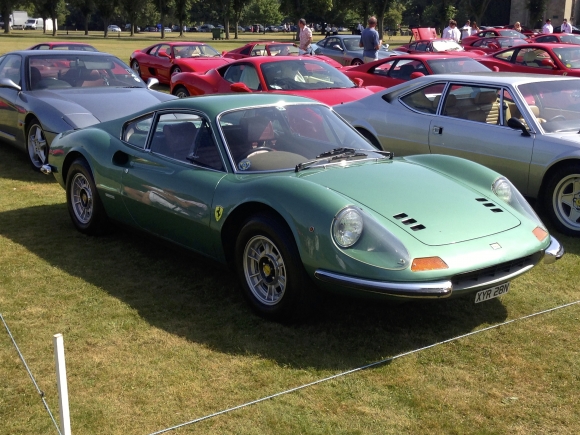
In 1968 Ferrari unveiled its own production car using the Dino V6 engine: the 206GT. However, the car did not carry the famous Prancing Horse badge but instead a badge with a stylised version of Dino Ferrari’s signature. Ferrari wanted the Dino to be a standalone brand with the Ferrari brand reserved for the V12 cars.
Regardless of badging, the 206GT introduced a number innovations for Ferrari. It was the first Ferrari road car with rack and pinion steering, and far more importantly it was the first Ferrari series production car to be mid-engined. Ferrari had produced the mid-engined 250LM before this but while this was nominally a road car, it was really a race car produced in very small numbers.
As usual, Ferrari turned to Pininfarina to clothe the 206 and they produced something of a masterpiece, with swooping curvaceous lines that were reminiscent of the Ferrari P series of sports prototypes. Elements of the shape can even be seen today in its modern equivalent, the Ferrari 458 Italia.
The body was finished in alloy and the 2.0 engine in specification was the same as the Fiat Dinos, though Ferrari claimed the engine produced 180bhp when used in the Ferrari. It’s likely that Ferrari was using a little artistic license with this power output in an attempt to distinguish their car from the lesser Fiats. Chief race engineer Mauro Forghieri, in his book "Forghieri on Ferrari", states that the Fiats were down on power due to a less than optimal exhaust arrangement for production reasons, so it's possible the discrepancy was down to the Ferrari having better breathing.
The 206GT had a very short production life with 150 units produced before production turned over to the 246GT. As the name implies, the engine was enlarged to 2.4 litres and was the same as the later Fiat Dinos. The bodywork was also changed to steel for ease of production. Ferrari now quoted 195bhp for the European versions and 175bhp for the emissions-strangled US cars. Despite its small engine size, the car was no slouch with a top speed of 148 mph and a 0-60 time of 7.1 seconds according to Motor magazine.
Road tests both then and now rave about the 246’s excellent handling, which was easily a match for its closest rival: the Porsche 911.
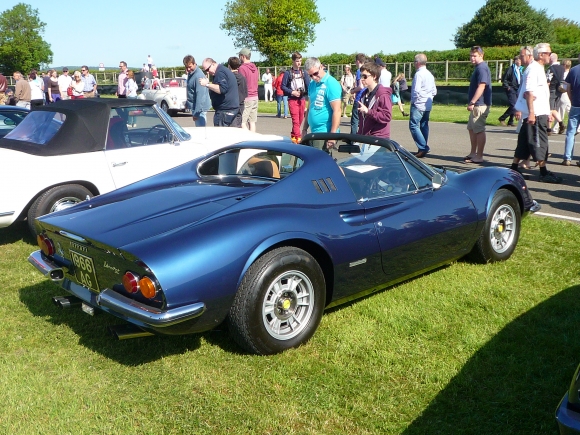
The most significant derivative was launched at the Geneva show in 1972, when the Targa topped 246GTS was launched. The styling of the rear buttresses was revised to accommodate the targa top with the rear side windows replaced by louvres, although the GT continued unchanged. In today's marketplace, cars with the so-called "Chairs and flairs" option are considered particularly desirable. Here the wheel arches are given noticeable flairs to accommodate wider Campagnolo wheels, while inside the seats are the same as those fitted to the 365GTB/4 Daytona.
Production continued through to 1973 before it was replaced by an all-new car. In total, 2732 GTs were built and 1175 GTSs. Clearly, if the GTS had been introduced earlier it would have outsold the GT.
Ferrari Dino 308GT4 /208GT4
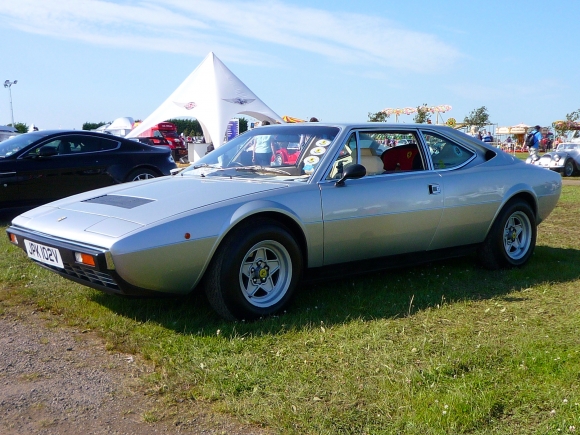
The 246’s replacement, the 308GT4, was a very different car. As the name implies, the long-running V6 engine was replaced by a new 90-degree 3.0 litre V8. The engine owed as much to the Ferrari V12s as it did to the V6 cars, sharing both the cylinder capacity and pistons with the 4.4 litre V12s. Fed by a quartet of Weber carburettors, the engine produced 255bhp in European form and 230bhp in US form.
With Fiat now in charge of Ferrari’s road cars they clearly had considered that the 2 seater 246 Dino had lost sales to the 2+2 911 and as a result the new 308GT4 was a 2+2. For the difficult task of shaping a mid-engined 2+2, Ferrari turned not to Pininfarina but to Bertone and their chief designer Marcello Gandini. The resulting car was a wedge shape, very much en vogue at the time, and it was neat and handsome but drew rather unfavourable comparisons with the previous 246. Why Ferrari went to Bertone is unclear. Doug Nye, in his book "Dino: the little Ferrari", speculates that it was because Ferrari had been impressed with Bertone during their production of the 2.4 litre Dino Coupés.
Performance was impressive, with a top speed of 154mph and 0-60 in 6.9 seconds according to Autocar. Again, the handling was highly regarded and the longer wheelbase made it a little more benign at the limit than the 246 and later 308GTB.
The car was launched into a very difficult market. Tightening emissions regulations meant that Ferrari had withdrawn its V12 models from the US market in 1973, so US Ferrari dealers only had the new 308GT4 to sell and this carried Dino badges rather than those of the Prancing Horse. Safety regulations in the States also meant that US-spec cars had to carry heavy and ugly bumpers to meet new crash regulations. Sales were slow and in 1975 the decision was made to replace the Dino badges with the Prancing Horse, to coincide with the launch of the Pininfarina-designed Ferrari 308GTB, effectively ending the Dino brand, although the GT4 still carried the Dino name on the rear and retained the even-numbered Dino chassis number sequence (the GTB followed the standard Ferrari odd-numbered sequence).
As part of the changes some slight styling alterations were made. A new and more attractive full-width grille was introduced, and the car now ran on the familiar 5-spoke Cromodora alloy wheels in common with the GTB.
During the Seventies, Italy had some very punative tax laws for cars with engines of more than 2.0 litres. In response, Ferrari produced a de-bored version of the 308GT4 known as the 208GT4. The engine was the world’s smallest production V8 and produced a claimed 180bhp. They sound rather good too, as seen below.
Production of both the 308 and 208GT4 continued until 1980 when they were replaced by the Pininfarina-designed and Ferrari-badged Mondial. In total, 2826 308GT4s and 840 208GT4s were produced.
Was the Dino Brand a success?
Brands usually wither and die because they were a failure, but I’m not sure this is true of the Dino brand. The 246 was easily Ferrari’s biggest selling product to date, selling four times more than the Daytona did at the same time, but I think that was in spite of the Dino badge rather than because of it. Certainly in some countries, notably the UK, dealers fitted the Ferrari script and prancing horse on the rear of the cars to emphasise they were Ferraris.
The 308GT4 was also probably the right car, but released at the wrong time. It wasn't a strong enough model to sustain the brand on its own and with it being the only model available to Ferrari’s US dealers, the decision to fit Ferrari badges was perhaps inevitable.
As for the Fiats, they certainly lifted what was rather a drab range for Fiat at the time but the acquisition of Ferrari itself meant they were no longer necessary for Fiat. Perhaps if the Fiat and Ferrari ranges had been combined into a proper separate brand rather than offshoots of the parent marques, it would still be around today.
The Dinos today
Fortunes of the Dino in the marketplace have ebbed and flowed over the years, partly due to the cars' susceptibility to rust. Now though, for the 206 and 246 at least, they're currently in huge demand with prices rising rapidly over the last few years.
The most desirable 246GTS with the "chairs and flairs" options can make up to £300,000 ($500,000) with the best 246GTs making maybe £200,000 ($330,000). Next comes the Fiat Dino Spyder, with the best of the rare 2.4 litre versions making £125,000 ($200,000).
The Fiat Dino Coupé and 308GT4 make similar money with the best cars fetching £30,000 ($50,000).
Which would I have?
If money were no object, it's hard to look beyond the 246. It’s the best looking of all the cars here, and the most iconic. I prefer the lines of the fixed head GT to those of the GTS, and yes, I would follow the market and go for one with chairs and flairs!
The trouble is, they've become expensive to the point that there are other alternatives at their price range that I would choose, and it seems rather silly that you could have all of the other Dinos for the price of one 246. The Fiat Dino Spyder has also got rather too pricey for my liking, although it is a very cool car and desirable beyond its humble Fiat badge.
The choice then comes down to either the Fiat Dino Coupé or the 308GT4. Both have always been considered underdogs and often purchased because of their cheap price by people who couldn't necessarily afford to maintain them. I love the 308GT4 but in fact I'd rather save a little more and have a Ferrari 308GTB, the subject of our next Know Your Ferraris article. The Fiat Dino Coupé comes with the Ferrari association but without the baggage. It’s a very cool car and I'd love to see a 2.4 litre version in my garage one day.
References
Dino: the Little Ferrari by Doug Nye
Forghieri on Ferrari; Mauro Forghieri and Danielle Buzzonetti
Original Ferrari V8: Keith Bluemel
All photos by the author
Videos courtesy of Petrolicious



